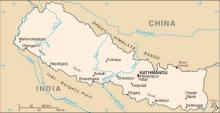Osmanabadi
Origin and distribution: The breed derives its name from its habitat and distributed in Ahmednagar, Solapur and Osmanabad districts in Maharashtra (Motghare et al 2005, Deokar et al 2006) where it is found in purest form. The breed is mainly concentrated and found in Latur, Parbhani, Ahmadnagar and Solapur district of Maharashtra besides Osmanabad. It has spread over a wide range of agro-climatic conditions in Vidharva, Marathada, Western – Maharashtra and adjoining parts of Karnataka and Andhra Pradesh.
Siddiqui et al (1981) studied early growth performance and estimated heritability for growth for this breed. Mandokmale et al (2009) reported least square means of body weight in kids under field conditions at birth and 3, 6 and 12 months of age which were 1.84±0.01, 7.69±0.06, 14.08±0.10 and 18.62±0.10 kg, respectively. They also observed significant effect of milk production on kids body weight growth. Koratkar et al (1998) studied reproductive performance and found breeding efficiency as 92 percent.
Physical Characteristics:The body colour is mostly black but some animals with white patches on ears, neck and sometimes on body are also found. The hair coat is short and shining face profile is straight, ears are of medium size and drooping. Most of the males are horned but about 5% of the females are polled.
Wattles are found in many animals. The adult males and females weight 34 and 32 kg respectively on an average. Deokar et al (2006) characterized Osmanabadi goats and observed that most of them were of black coat colour, with grey white skin, black muzzle, eyelids and hooves, possessing grey straight and backward oriented horns (13.01 cm length), pendulous ears (4.83±0.08 cm length), convex head type, absence of wattles and beard, and curved, slender and medium-length tail Osmanabadi is a medium sized breed with comparatively long body ad long legs. The average body length, body height and heart girth is 69, 77 and 72 cm in males and 68, 75 and 72 cm in females.
Performance: The average age at first kidding and kidding interval is 523 and 214 days respectively. Goats of this breed have very efficient reproduction and in well managed flocks (Koratkar et al, 1998), with 30% twining and 2% triplets.
The daily milk yield ranged from 700 gm to 1500 gm under well managed village flocks with lactation length of 130-150 day. Sawaimul et al (2009) observed overall survivability rate of Osmanbadi goat under farmers’ condition as low as 68.87%, whereas in adult and kids it was found to be 81.60% and 47.16% respectively. Very high mortality in kids suggests early loss of valuable genetic material in farmers’ condition. Osmanbadi Sahare et al (2009) found that in Osmanabadi goat maintained under farm condition, kidding percentage and twinning ability was 55.87% and 10.52% respectively.
Table 1 Average performance of Osmanabadi goat in India as reported by Lawer et al (2008)
|
Trait |
Average |
|
Age at first oestrus (days) |
219.34±0.72 |
|
Age at first mating (days) |
233.02±0.89 |
|
Weight at first conception (kg) |
19.66±0.07 |
|
Age at first kidding (days) |
385.95±2.98 |
|
weight at first kidding (kg) |
23.68±0.05 |
|
kidding interval (days) |
216.77±1.67 |
|
gestation length (days) |
148.87±0.89 |
|
oestrus duration (hours) |
36.25±0.08 |
|
Days open (days) |
68.21±0.42 |
|
Oestrus cycle duration (days) |
21.49±0.03 |
|
Twining rate (%) |
70.67 |
Kamble et al (2009) observed age at puberty, first service and first conception as 335.3±13.0, 370±14 and 375±14 days respectively indication that the breed is early maturing. Mandakmale et al (2007) studied carcass traits in Osmanabadi goat, having pre-slaughter weight of 11.76±0.13, 13.88±0.25 and 19.46±1.88 kg, at ages of 6, 9 and 12 months, respectively. The carcass weight of 4.99±0.19, 6.37±0.13 and 9.57±0.97 kg was found with dressing percentage of 42.43±1.32, 45.87±0.30 and 49.17±1.00 in the same age order, respectively
References





